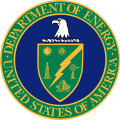| Deputy Secretary of Energy | |
|---|---|
 Seal of the U. S. Department of Energy | |
| United States Department of Energy | |
| Reports to | U. S. Secretary of Energy |
| Seat | Washington, D.C., United States |
| Appointer | The president with Senate advice and consent |
| Website | www |
The deputy secretary of energy is a high-ranking position within the United States Department of Energy. The deputy secretary is the second-highest-ranking official of the department and assists the secretary of energy in the supervision and direction of the department. The deputy secretary succeeds the secretary in their absence, sickness, or unavailability.
Contents
The deputy secretary is appointed by the president with the consent of the United States Senate to serve at the request of the president.















